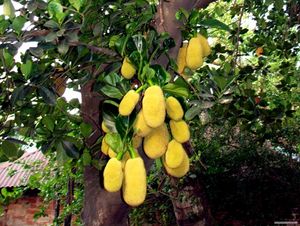Note: This is a project under development. The articles on this wiki are just being initiated and broadly incomplete. You can Help creating new pages.
Difference between revisions of "Artocarpus hirsutus - Wild Jack, Jungle Jack"
(→Fruit) |
(→References) |
||
| Line 69: | Line 69: | ||
</references> | </references> | ||
<references> | <references> | ||
| − | <ref name="Leaf">[https://indiabiodiversity.org/species/show/8066 " | + | <ref name="Leaf">[https://indiabiodiversity.org/species/show/8066 "morphology"]</ref> |
</references> | </references> | ||
Revision as of 17:43, 2 April 2018
Artocarpus hirsutus is a tree seen in evergreen and semi-evergreen forests from south Maharashtra to Kanyakumari.
Contents
Uses
Helpful in treating Pimples, Cracks in Skin, Sores, Diarrhoea, Skin diseases, Intrinsic haemorrhage, Poisons.
Parts Used
Bark, Dried Leaves, Leaves, Fruits.
Chemical Composition
The Artocarpus species are rich in phenolic compounds including flavonoids, stilbenoids, arylbenzofurons and Jacalin, a lectin.[1]
Common names
- Kannada - Hebbalasu, Kadu halasu
- Malayalam - Ayani, Anjili, Ayini plavu
- Sanskrit - Lakucha, Lakucah, Panasah
- Tamil - Kattuppala, Aiyini pala, Kurangu pala, Pei pala
- Telugu - Adavi panasa
- Hindi - Kathal
Habit
Identification
Leaf
Leaves simple, alternate, spiral, clustered at twigs end; stipules to 2.5 cm long, lanceolate, tawny hirsute, caducous, leaving annular scar; petiole 1.3-3 cm long, stout, subterete or planoconvex, hirsute; lamina 10-30.5 x 5-14 cm, usually ovate to broadly elliptic, apex subacute or shortly acuminate, base rounded or subacute, margin entire or undulate (lobed when young), coriaceous, drying brown, densely hirsute beneath when young, later become glabrous except on midrib and nerves; midrib flat above; secondary nerves 10-12 pairs, ascending; tertiary nerves broadly reticulo-percurrent.[2]
Flower
Flowers unisexual; male flowers in axillary spikes, pendulous, 14 cm long; female flowers in axillary spikes, ovoid
Fruit
Syncarp (sorosis), subglobose or ellipsoid with long echinate processes, orange when ripe; seeds many, ovoid.
Other features
List of Ayurvedic medicine in which the herb is used
- Vishatinduka Taila as root juice extract
Where to get the saplings
Mode of Propagation
How to plant/cultivate
In terms of taking care of the plant, minimal pruning is required Cutting off dead branches from the interior of the tree is only sometimes needed. In addition, twigs bearing fruit must be twisted or cut down to the trunk to induce growth for the next season. Branches should be pruned every three to four years to maintain its productivity. Stingless bees such as Tetragonula iridipennis are jackfruit pollinators, and as such, play an important role in jackfruit cultivation.
Commonly seen growing in areas
Photo Gallery
References
- ↑ "ethnopharmacology"
- ↑ Cite error: Invalid
<ref>tag; no text was provided for refs namedLeaf
Cite error: <ref> tag defined in <references> has group attribute "" which does not appear in prior text.
External Links
- Artocarpus hirsutus on ENVIS Centre on Conservation of Medicinal Plants
- Artocarpus hirsutus on India Biodiversity Portal
- Artocarpus: A review of its traditional uses, phytochemistry and pharmacology
- Artocarpus: A review of its phytochemistry and pharmacology
- Pharmacognostical studies on the bark of Artocarpus hirsutus Lam
- Pages with reference errors
- Pages that are stubs
- Ayurvedic Herbs known to be helpful to treat Pimples
- Ayurvedic Herbs known to be helpful to treat Cracks in Skin
- Ayurvedic Herbs known to be helpful to treat Sores
- Ayurvedic Herbs known to be helpful to treat Diarrhoea
- Ayurvedic Herbs known to be helpful to treat Skin diseases
- Ayurvedic Herbs known to be helpful to treat Intrinsic haemorrhage
- Ayurvedic Herbs known to be helpful to treat Poisons
- Herbs with Bark used in medicine
- Herbs with Dried Leaves used in medicine
- Herbs with Leaves used in medicine
- Herbs with Fruits used in medicine
- Habit - Tree
- Index of Plants which can be propagated by Seeds
- Index of Plants which can be propagated by Cuttings
- Index of Plants which can be propagated by Airlayers
- Herbs that are commonly seen in the region of Western Ghats
- Herbs that are commonly seen in the region of Malabar Coast
- Herbs









